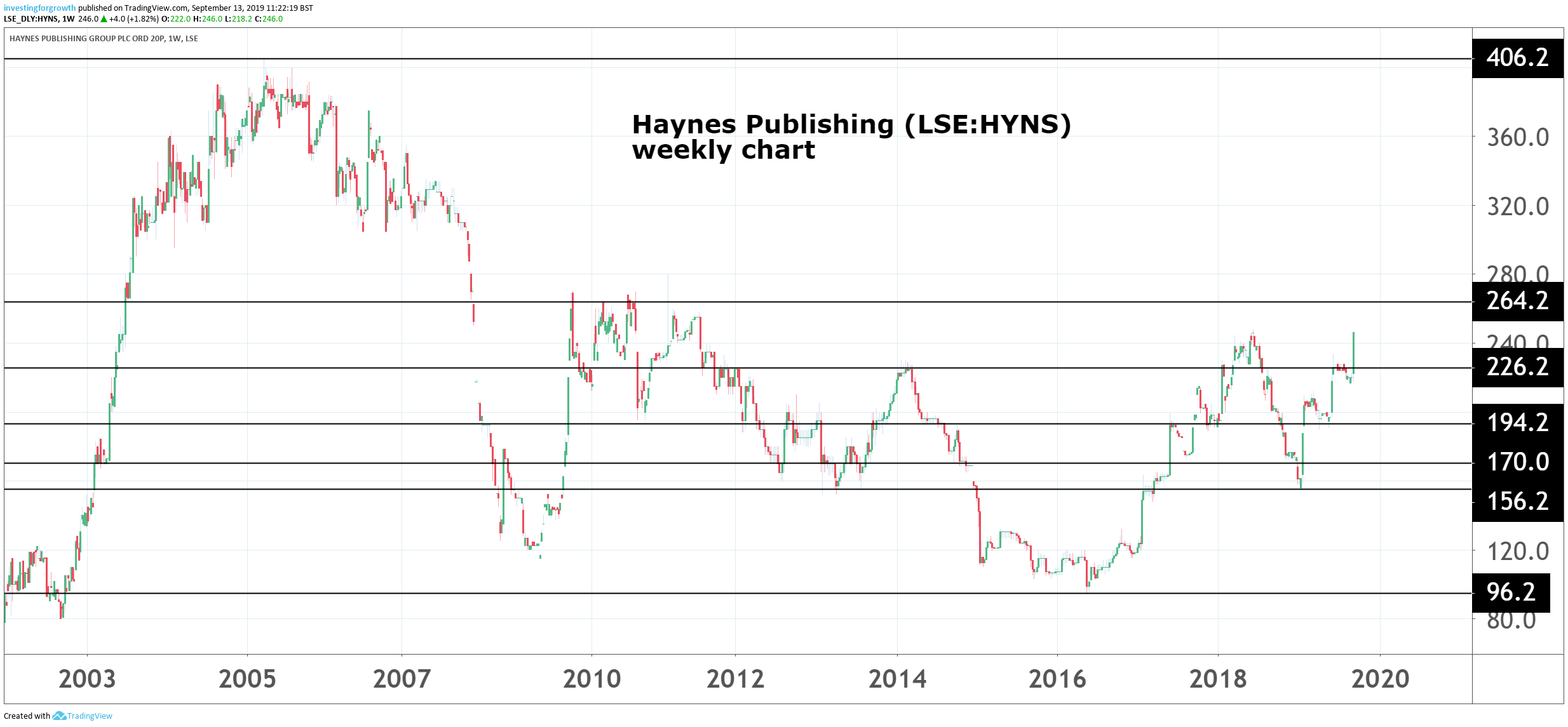Stockwatch: A defensive stock for a recession
It doesn't win for capital growth or income appeal, but this company should have a secure future.
13th September 2019 11:18
by Edmond Jackson from interactive investor
It doesn't exactly win for capital growth or income appeal, but this company should have a secure future.

The latter part of August and early September has seen a remarkable rebound in risk plays under the kosh. Among financial stocks, Aviva (LSE:AV.) and Legal & General (LSE:LGEN) are up about 10%, reflecting how financial stocks often lead any change in risk perception.
President Trump's pressure on the Federal Reserve to cut interest rates, also the US and China backing off their threats to further raise tariffs from a total 25% currently on sum trade (from 5% at the start of 2018), are conflating with a no-deal Brexit (indeed any Brexit at all) looking stymied, as the UK Establishment thwarts every conceivable move by government.
It's why retail property stocks such as Hammerson (LSE:HMSO)and NewRiver REIT (LSE:NRR) have leapt over 20%, and recovery plays such as Kier Group (LSE:KIE) have nearly doubled from mid-summer lows.
Such a 'risk assets' party is exposed to US/China trade conflict re-igniting, and at home to worsening politics. The prospect of a hung parliament jumps if the Tories continue to dismiss any pact with the Brexit Party at the next general election – the only way they seem likely to achieve any majority when "Remainers" will split between Labour and the Liberal Democrats.
Facing such a morass, I was thinking that the kind of stocks to prioritise should be in well-established UK companies with strong overseas operations, offering more essential rather than discretionary products/services, decent margins, cash generation and low/no debt.
One shouldn't worry overly about sterling risk because hedge funds have shorted assuming "no deal", hence there's potential for some rebound, and low sterling anyway will prompt more foreign buyers of UK plc.
Re-adapting to a professionals, internationally
Coincidentally, Haynes Publishing Group (LSE:HYNS) - offering vehicle and motorcycle repair manuals - has just declared stonking results to 31 May, as it benefits from restructuring in recent years. The shares are up over 10% to 243p as investors sense potential for investment spend to deliver.
Capitalised at £37 million, it may appear the kind of market-fringe stock exposed to much downturn; and for a company that listed in 1979, a current valuation that's in the mid-range on its all-time chart hardly inspires for capital growth. The extent of YouTube videos and the like, plus the prospect for electric cars requiring even less attention than today's modern vehicles, can suggest Haynes is doing well not to fizzle out.

Source: TradingView Past performance is not a guide to future performance
Yet Haynes has adeptly reinvented itself towards professional mechanics in both an international and digital context. It's why revenue from its professional segment is up 20% to £19.5 million, offsetting a 4% slip in consumer to £16.7 million, albeit with digital consumer revenues up 38% in the UK, 32% in the US and 72% in Australia. Altogether, group revenue is up 7% to £36.2 million.
The price/sales ratio has only just crept over 1.0 and the operating margin is a respectable 11.6%. Normalised pre-tax profit is up 24% to £3.6 million backed by net cash from operations up 21% after tax to £12.5 million, eliminating debt and near-doubling net cash to £4.9 million.
Admittedly, the seven-year record in the table implies much still to be delivered to genuinely re-rate this stock: revenue has only quite recently started to advance, profits are rather volatile and the dividend is static at 7.5p, hence a modest 3% yield. It doesn't exactly win for capital growth or income appeal.
Benefits from restructuring, acquisitions and investment
An uplift in the last three years is part-explained by the acquisition of OATS (one of only two lubricants database specialists in the world) for £2.4 million in 2016/17 and of E3 (technical repair/maintenance information and vehicle registration look-up) for £4.7 million in 2018/19. Without E3, revenue rose 5% in the last year.
The disproportionate rise in profits/earnings is cited as reflecting the culmination of a five-year-restructuring programme, but is tricky to decipher financially, the income statement showing cost of sales as a percentage of revenue down from 40.4% to 38.0%, and adjusted distribution costs down from 24.1% to 22.8%. However, adjusted administrative expenses rose from 25.2% to 27.8%.
In the last 12 months, £8.7 million has been spent to expand and update content, over two-thirds of which applies to the professional business. Obviously you need to consider what extent of capital expenditure is needed just to stay relevant and competitive: see from the table how Haynes has always made substantial capex relative to operating cash flow. It's why free cashflow declined from 17.9p in respect of the 2015 year to 7.8p in 2018, though it appears to have rebounded near 23p in the last financial year, possibly a sign of restructuring benefits. Capex needs seem a likely chief reason the dividend has kept static for years.
| Haynes Publishing Group - financial summary | |||||||
|---|---|---|---|---|---|---|---|
| year ended 31 May | |||||||
| 2013 | 2014 | 2015 | 2016 | 2017 | 2018 | 2019 | |
| Turnover (£ million) | 27.6 | 29.3 | 26.1 | 25.7 | 29.8 | 33.8 | 36.2 |
| Net profit (£ million) | 2.2 | 1.2 | -5.9 | -1.8 | 1.4 | 1.5 | 1.4 |
| Operating margin (%) | 13.1 | 9.0 | -25.8 | -7.6 | 10.9 | 12.3 | 6.7 |
| IFRS3 earnings/share (p) | 14.2 | 7.4 | -39.2 | -11.8 | 9.1 | 9.8 | 9.2 |
| Normalised earnings/share (p) | 14.2 | 25.0 | 40.3 | 26.6 | 12.6 | 13.2 | 19.0 |
| Price/earnings multiple (x) | 12.2 | ||||||
| Operational cashflow/share (p) | 42.8 | 41.0 | 57.4 | 51.3 | 65.4 | 66.4 | 82.5 |
| Capital expenditure/share (p) | 22.2 | 43.1 | 39.6 | 44.0 | 55.2 | 58.6 | 59.6 |
| Free cashflow/share (p) | 20.7 | -2.1 | 17.9 | 7.3 | 10.2 | 7.8 | 22.9 |
| Dividend per share (p) | 7.5 | 7.5 | 7.5 | 7.5 | 7.5 | 7.5 | 7.5 |
| Dividend yield (%) | 3.2 | ||||||
| Covered by earnings (x) | 1.9 | 1.0 | -5.2 | -1.6 | 1.2 | 1.3 | 2.5 |
| Net assets per share (p) | 259 | 234 | 175 | 160 | 137 | 169 | 152 |
| Source: historic Company REFS and company accounts | |||||||
Vague outlook but clearly a bid target
No guidance on current trading is given in the chairman's outlook statement beyond: "accelerating the linking of the group's content and datasets...to deliver new and exciting global opportunities by organic growth and strategic acquisition." You'd think the advent of electric cars might be discussed in terms of identifying new opportunities, both to show Haynes is on-the-ball – to offer a new generation of specialist help – and deal with any sense of threat.
Meanwhile, and lest the global economy ebbs, it's encouraging to read in the operational review how Haynes' market-leading diagnostics for electrical/component faults is installed in over 25,000 devices throughout Europe. My hunch is, a declining new vehicle market as buyers await better electric capability, means servicing should be stable or increase.
All-considered - especially Haynes' market-leading positions and sterling weakness as Brexit wrangles on - and it looks an obvious takeover target. The counter to which is the semblance of a controlled company, the company's website and past annual reports seem to obfuscate.
"Substantial shareholdings" pages cite 10.3% on behalf of Haynes Motor Museum and 5.3% held by AC Haynes (the founder's widow) then various institutional stakes at 10% and below. However, past annual reports (e.g. page 45 in the 2018 report) cite 9 million shares held by JH Haynes and 8.6 million held by JHC Haynes (additional to 0.5 million non-beneficial) as connected parties.
Founder director John Haynes passed away in February and it's a fair guess the CEO "J Haynes" is his son. There has been no clarification as to the status of 9 million shares – i.e. near-60% of the issued capital – as part of any estate settlement although "family trusts" are cited in the 2018 annual report and it seems most likely the Haynes family remains in control.
Yet, that doesn't prevent anyone making an offer for them to consider an exit and or potentially secure greater international scope for Haynes like we've just seen AIM-listed Sanderson IT achieve by linking up with an American parent. Now would be an ideal time after the restructuring and investments having been made, with sterling weak to enhance the value of an overseas offer. I suspect a reason Miton Group (LSE:MGR) owns 10.2% with other institutions – effectively locked in - is the ultimate prospect of takeover.
Although the stock has just risen over 10% to 243p, on a long-term view it's mid-way between an 80p to 400/450p range going back 20 years. The price/earnings (PE) multiple is about 12 times and free cash flow (if sustained) of about 10, which is again attractive to a bidder.
I wouldn't major on takeover prospects, just as an off-chance sweetener for a stock that looks well-qualified anyway for these uncertain times. Vehicle servicing and related information has a secure future so long as Haynes continues to adapt. Buy.
Edmond Jackson is a freelance contributor and not a direct employee of interactive investor.
These articles are provided for information purposes only. Occasionally, an opinion about whether to buy or sell a specific investment may be provided by third parties. The content is not intended to be a personal recommendation to buy or sell any financial instrument or product, or to adopt any investment strategy as it is not provided based on an assessment of your investing knowledge and experience, your financial situation or your investment objectives. The value of your investments, and the income derived from them, may go down as well as up. You may not get back all the money that you invest. The investments referred to in this article may not be suitable for all investors, and if in doubt, an investor should seek advice from a qualified investment adviser.
Full performance can be found on the company or index summary page on the interactive investor website. Simply click on the company's or index name highlighted in the article.
Disclosure
We use a combination of fundamental and technical analysis in forming our view as to the valuation and prospects of an investment. Where relevant we have set out those particular matters we think are important in the above article, but further detail can be found here.
Please note that our article on this investment should not be considered to be a regular publication.
Details of all recommendations issued by ii during the previous 12-month period can be found here.
ii adheres to a strict code of conduct. Contributors may hold shares or have other interests in companies included in these portfolios, which could create a conflict of interests. Contributors intending to write about any financial instruments in which they have an interest are required to disclose such interest to ii and in the article itself. ii will at all times consider whether such interest impairs the objectivity of the recommendation.
In addition, individuals involved in the production of investment articles are subject to a personal account dealing restriction, which prevents them from placing a transaction in the specified instrument(s) for a period before and for five working days after such publication. This is to avoid personal interests conflicting with the interests of the recipients of those investment articles.